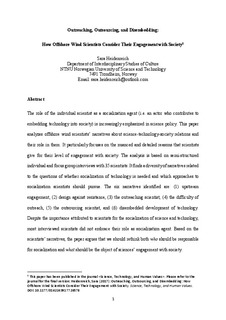| dc.contributor.author | Heidenreich, Sara | |
| dc.date.accessioned | 2017-08-30T11:43:24Z | |
| dc.date.available | 2017-08-30T11:43:24Z | |
| dc.date.created | 2017-08-22T20:00:19Z | |
| dc.date.issued | 2017 | |
| dc.identifier.citation | Science, Technology and Human Values. 2017, 1-23. | nb_NO |
| dc.identifier.issn | 0162-2439 | |
| dc.identifier.uri | http://hdl.handle.net/11250/2452400 | |
| dc.description.abstract | The role of the individual scientist as a socialization agent (i.e., an actor who contributes to embedding technology into society) is increasingly emphasized in science policy. This article analyzes offshore wind scientists’ narratives about science–technology–society relations and their role in them. It particularly focuses on the nuanced and detailed reasons that scientists give for their level of engagement with society. The analysis is based on semistructured individual and focus group interviews with thirty-five scientists. It finds a diversity of narratives related to the questions of whether socialization of technology is needed and which approaches to socialization scientists should pursue. The six narratives identified are (1) upstream engagement, (2) design against resistance, (3) the outreaching scientist, (4) the difficulty of outreach, (5) the outsourcing scientist, and (6) disembedded development of technology. Despite the importance attributed to scientists for the socialization of science and technology, most interviewed scientists did not embrace their role as socialization agent. Based on the scientists’ narratives, this article argues that we should rethink both who should be responsible for socialization and what should be the object of sciences’ engagement with society. | nb_NO |
| dc.language.iso | eng | nb_NO |
| dc.publisher | SAGE Publications | nb_NO |
| dc.title | Outreaching, Outsourcing, and Disembedding: How Offshore Wind Scientists Consider Their Engagement with Society | nb_NO |
| dc.type | Journal article | nb_NO |
| dc.type | Peer reviewed | nb_NO |
| dc.description.version | acceptedVersion | nb_NO |
| dc.source.pagenumber | 1-23 | nb_NO |
| dc.source.journal | Science, Technology and Human Values | nb_NO |
| dc.identifier.doi | 10.1177/0162243917726578 | |
| dc.identifier.cristin | 1488013 | |
| dc.relation.project | Norges forskningsråd: 190977 | nb_NO |
| dc.relation.project | Norges forskningsråd: 209697 | nb_NO |
| dc.description.localcode | This is the authors' accepted and refereed manuscript to the article. | nb_NO |
| cristin.unitcode | 194,62,40,0 | |
| cristin.unitname | Institutt for tverrfaglige kulturstudier | |
| cristin.ispublished | true | |
| cristin.fulltext | postprint | |
| cristin.qualitycode | 2 | |
